During an online wasp identification course I participated in several weeks ago, there was a fun discussion about whether commercially-produced figs contained fig wasps (Agaonidae, in the Chalcidoidea). Opinions varied, plus some asserted, as do many internet pages, that even if wasps were once inside the figs that ficain (an enzyme) would completely dissolve their bodies. So I purchased a bag of figs and had a look. I found a wasp in the very first fig, in approximately two seconds. And I found much more than that. Photographic details below.
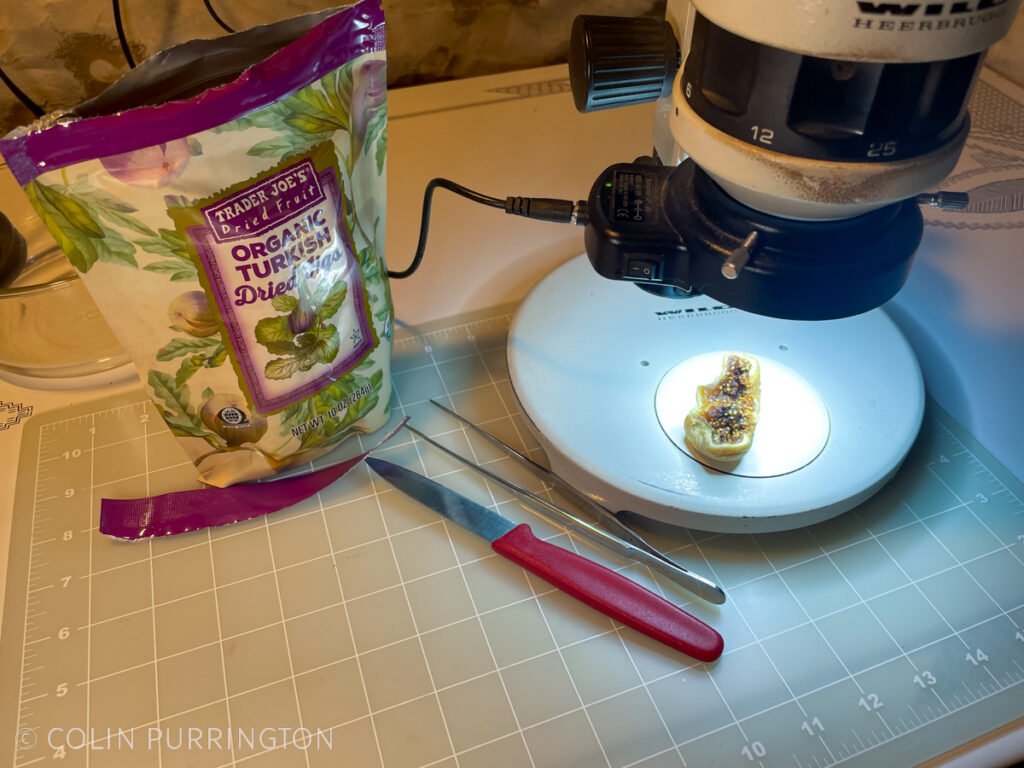
The wasp was small, like most wasps, so here’s a photograph with an arrow pointing out the position. It was wedged in between some of the involucral bracts just inside the ostiole (opening) of the syconium (the “fruit” that is actually an inverted infructescence). I’m not sure whether the wasp was going in or going out.
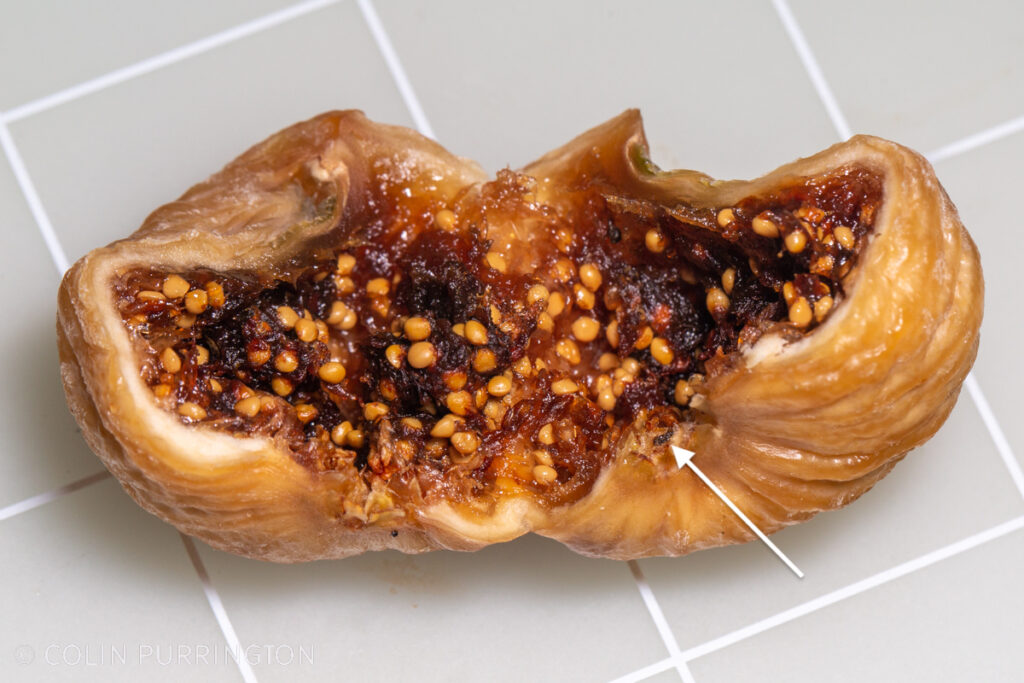
Here’s a close-up of the wasp, or at least what’s left of it. The shape and positions of the legs seem to be a good match for Blastophaga psenes, the sole pollinator (I think) of Ficus carica. In particular, the middle femorae are much smaller than the front and hind femorae. And the head is wedge-shaped, another attribute of the family.
The species exists in Turkey and in many other places where figs are grown. E.g., it’s in California because it was deliberately introduced there in 1899. This means, of course, that figs grown in California may have wasps in them, too. I’m just the messenger.
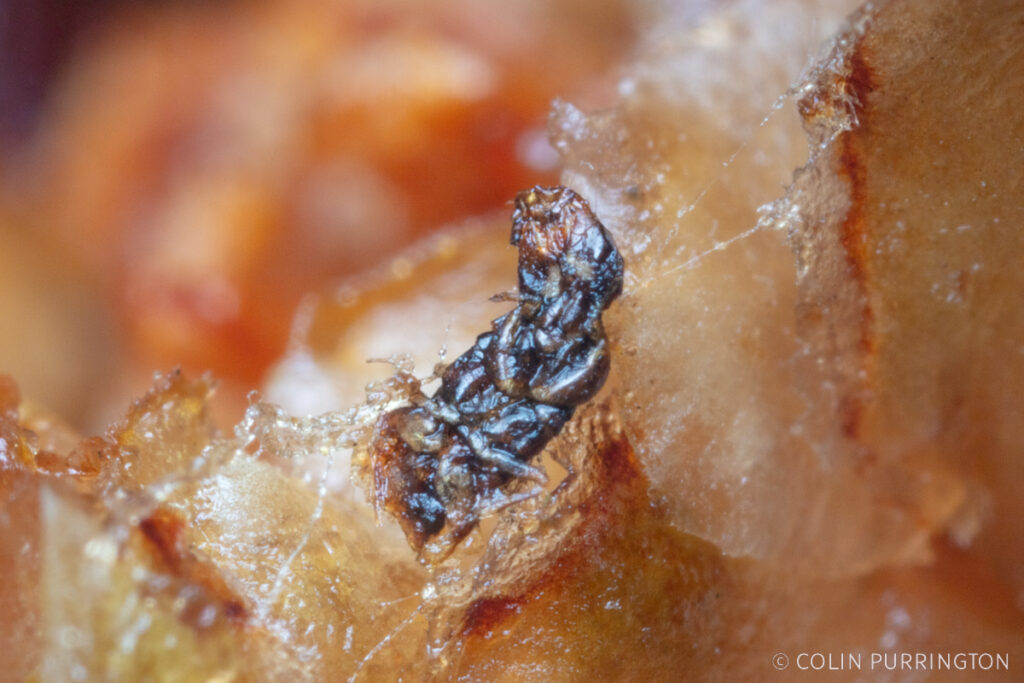
Below is the dorsal side showing (I think) the quadrate scutellum, another family characteristic. The antennae appear to be folded medially into a streamlined position that I assume is useful for navigating the bract maze. I have more pics on iNaturalist.
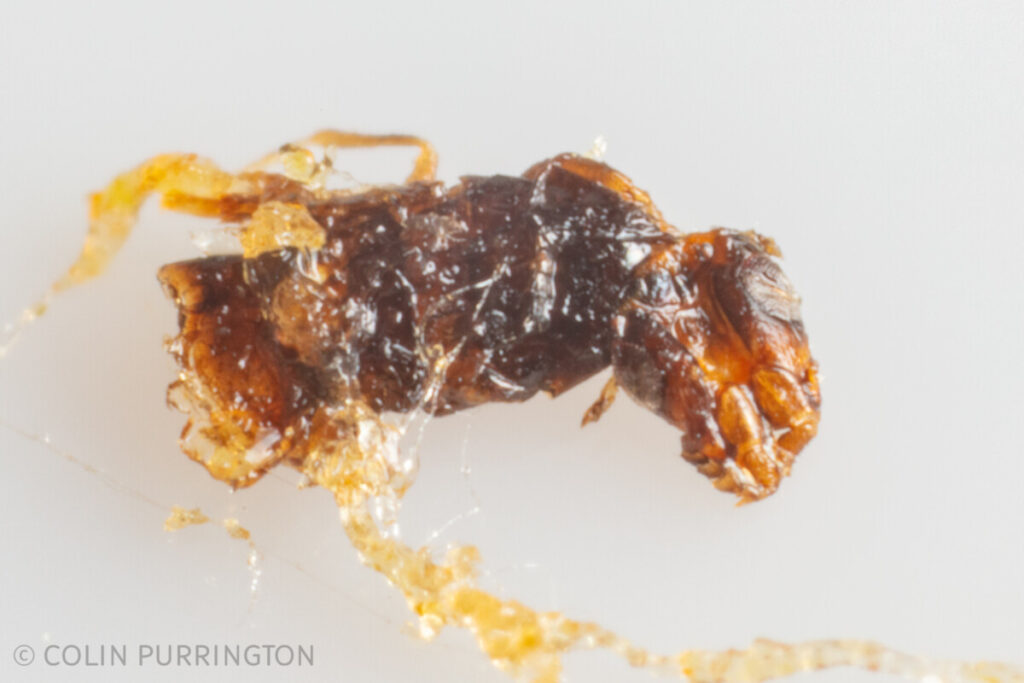
In a different fig, I found two more wasps of a second species. I don’t have a high confidence in my identification but I think they might be Habrobracon hebetor (Braconidae). This species is a regular inside stored figs because it parasitizes caterpillars that eat dried fruit. This wasp, I’m guessing, oviposited into caterpillar-infested figs after they arrived in California (where Trader Joe’s presumably has a warehouse). I don’t know whether the species occurs in Turkey. I have more pics on iNaturalist.

Below is a caterpillar in the same fig as the wasp above. Caterpillars were present in several other figs, too, and they were often accompanied by fungal growth. I don’t have an identification guess but if you recognize it please visit my iNaturalist observation.
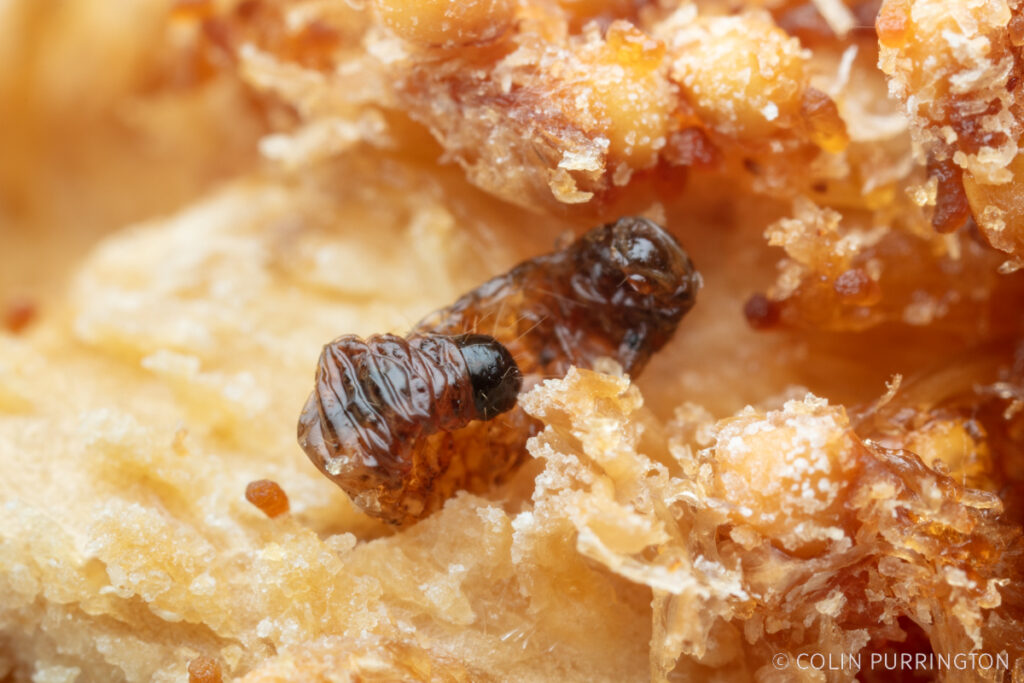
I’m not sure whether it’s a different species, but the cocoons below seem to be lepidopterans, too. Here is the iNaturalist link.
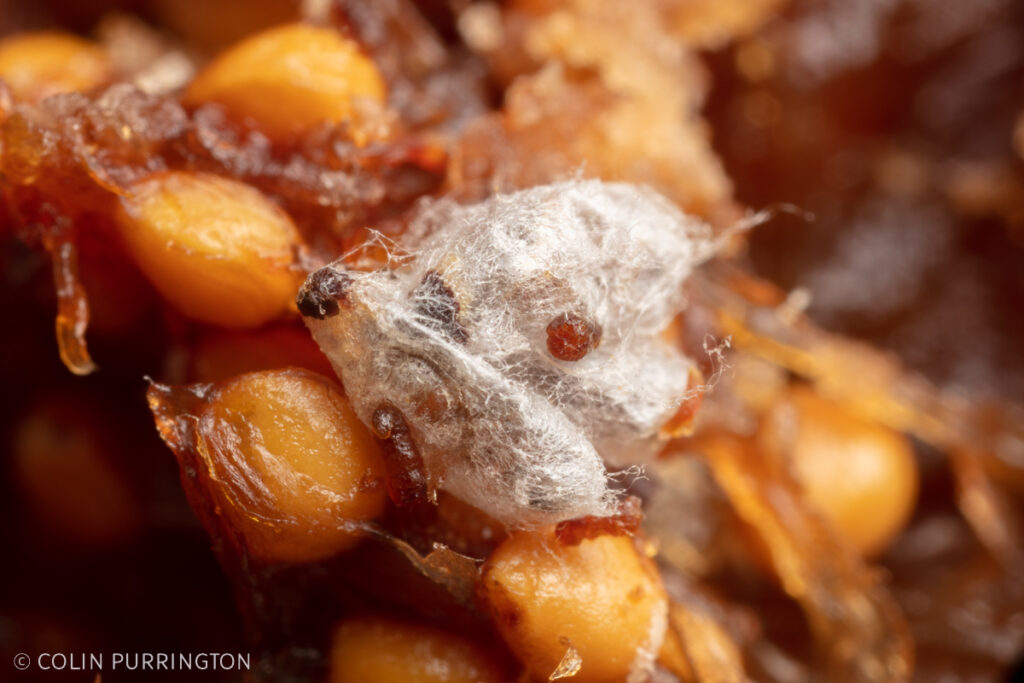
Here’s the final type of lepidopteran I found, a pupa. Again, I’m not sure what family it might be in. Here’s the iNaturalist listing. The photograph also shows a good quantity of frass, something I found in many of the figs even when I couldn’t locate a caterpillar. The dark color on the left is from fungal growth.
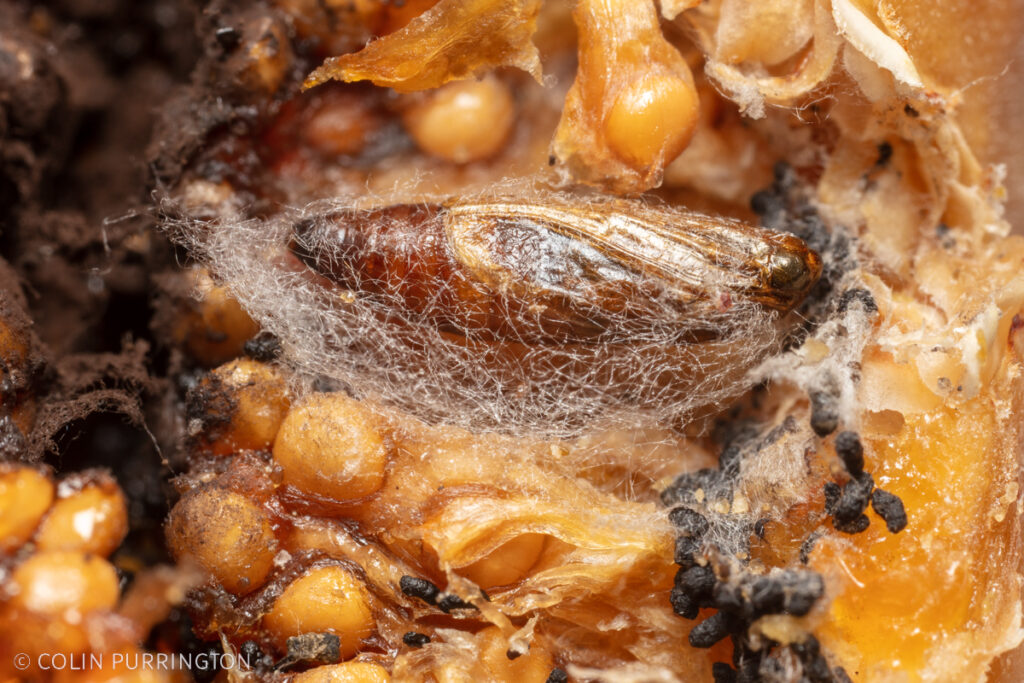
The final insect that turned up is a beetle, which I think might be Carpophilus hemipterus, a species native to Asia but now pretty much everywhere. It’s definitely in California. Here’s my iNaturalist observation if you’d like to weigh in on the identification.

I’d like to point out that insects are extremely common in stored food so the above doesn’t come as a huge surprise to me. And the figs were clearly labelled “organic”, a term that to me greatly boosts the likelihood that there are organisms inside. Unless you have an allergy to chitin or some other insect component (it happens), inadvertent consumption of arthropods isn’t going to harm you.
What did surprise me was how common fungal growth was in this bag of figs. Below is a photograph of what the fungus usually looked like. Not sure what it is (Aspergillus niger?). Some of them were mildly lit up by 356nm UV light, by the way. I think that’s a bad sign.
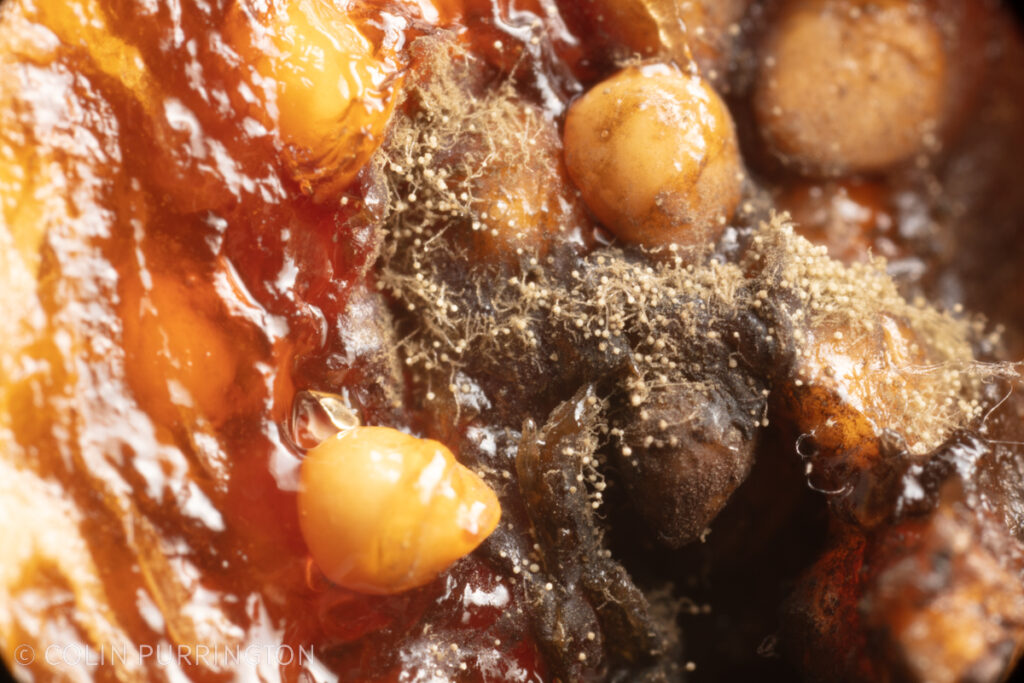
But a little research turned up what might be the obvious explanation: wasps that manage to crawl into figs via ostiole can be covered with fungal spores in the same way that they are often covered with pollen (that’s the whole point of fig wasps). Indeed, some fig farmers regularly spray anti-fungals onto figs before the females emerge to prevent them from picking up spores and transmitting them to the next fig. Without such treatment (i.e., at organic farms), it’s not rare to find smuts (Aspergillus spp.), endosepsis (Fusarium spp.), and Alternaria rot. Aside from potentially changing the taste of dried figs, I guess there’s a chance you could get a dose of aflatoxins. There’s research on the issue, even articles on the risk from dried Turkish figs.
When fresh figs start to arrive from California I might sacrifice some for a similar investigation. I’d love to find a fig wasp in better condition so I can photograph it. They are bizarre. But per several sources, many (most?) of the figs in California are produced by plants that don’t need fertilization, so finding one might be a challenge. Still, because fig wasps are naturalized in California, I wouldn’t be surprised if they’d still show up inside those varieties. As a demonstration that wasps are alive and well in California, you can order wasp-laden figs online at FigBid.com (e.g., this listing). Note that you don’t order such figs for eating. They are for placing near your crop of figs so that they can get pollinated. Some of the most delicious varieties of figs need such pollination. And some of the varieties that don’t need figs still develop much tastier fruit when they are pollinated by wasps.
Here’s what the California Fig Advisory Board has to say,
“https://californiafigs.com/faq/#:~:text=I%E2%80%99ve%20heard%20that%20there%20are%20wasps%20in%20figs.%20Is%20this%20true%3F
Next on my to-do list is to find the coffee berry borer (Hypothenemus hampei).
Resources
- Gods, Wasps and Stranglers (a fantastic book)
- “Are there wasps in my Newtons?” (a fantastic blog)
- “Are figs really full of baby wasps?“
- “Fig in California“
- “A wasp works wonders for Smyrna figs“
- “I’ve heard that there are wasps in figs. Is this true?” (CA Fig Advisory Board)

well, I may never eat a packaged fig again! LOL I knew the wasp/fig situation but wow, a caterpillar pupa! All fascinating and simultaneously stomach churning! Thanks for the insight—I may have to buy a package for curiosities sake, though my microscope isn’t as good as yours!
I hope you get a package to look through. Definitely a fun way to spend a rainy afternoon. By the way, I bought a cheap gizmo for attaching my phone to a microscope. Works great.
At Chicago, we’d sometimes go to one of the Whole Foods on the North Side, and I’d gawp and cheer for the exotic dipteran diversity circling the imported fruits. I suspect Chicago winters reduced the risk of invasive species. But for me these rare excursions out of Hyde Park were like trips to topical zoos.
Hope this finds you well.
Frass? No thanks!
It’s amazing how much frass those caterpillars generate!
Farmer here. Dried figs are almost always Smyrna figs, which are pollinated by wasps in California as well. Fresh figs, also known as common figs, do not need pollination to set fruit.
This blog post has more info: https://ucanr.edu/blogs/blogcore/postdetail.cfm?postnum=15080
Well I guess you are wrong about Izmir(smyrna you call it) figs. Most figs produced in Turkey are from Aydin (nearly half of Turkey’s figs are produced there).
as a Turkish person with a fig tree in my garden I now have a new fobia
Please go open a few figs up … I want to see what you have.
I don’t know where you are, but I’m about 20 minutes from Napa. We have a single fig tree in the backyard, this is the first year I’ve ever had fresh figs.
I constantly looked for bugs and then just didn’t care and ate them anyway, lol….
I guess my point is, if you’re anywhere close to Napa I can provide you with some fresh figs this summer from a solitary tree.
Oh, fascinating! This might be the excuse I need to come for another wine tour. I’m currently in Swarthmore, Pennsylvania, but most of family lives in California and Oregon. Please keep an eye on your figs and take pics of any small wasps that are lurking. If you’re bored, that is. Thanks for comment and offer.
It’s quite a different perspective. Off the subject, were the figs good?
Each fig is in a a separate container at the moment just in case I needed to revisit an insect for identification. But I do like this fig quite a lot and have purchased in dozens of times in the past.
Although it may seem surprising, this is a sign of high-quality organic food. It is a general rule of thumb to never eat anything that nature itself doesn’t want to eat ;)
I think the presence of insects that move into the figs during storage is likely not a sign of quality. But that’s just me.
This reminds me of what I read somewhere about how, when vegetarian Indians started living in England in large numbers they would often have dietary deficiences. The story was that traditional processing left a lot of insects, and the much needed nutrients they contained, in their diets. Industrial processing of the same foods did not. Now I wish I could remember my source because I have doubts.
That’s fascinating and something I’ve wondered about. If you find the reference someday please think of me. Would love to read more.
I don’t remember reading this book but apparently this is a quote from “An orchard invisible : a natural history of seeds” by Jonathan W. Silvertown.
“in the mid-1970s it was found that orthodox Hindus who had been quite healthy on a vegan diet in their native India began to suffer from a high incidence of metaloblastic anemia after living for some time in England consuming the same diet. The cause was traced to vitamin B-12 deficiency, which in India was prevented by insect contamination of grains.” (pp. 168-169)
Awesome. I need to dig around a bit but I’d love to add something about this to my post. Thanks again.
I hope finally you get a lesson on buying Turkish product from some company named ‘Joe’. Instead of searching bugs, you can make sure on fig’s nationality first. Try to buy figs from Turkey next time. Ps: you don’t need microscope/magnet to see f****** wasp in a fig.
Speaking as a vertebrate morphologist, the part of your post that really freaked me out was “the middle femorae are much smaller than the front and hind femorae”. Where I come from, the front femora are called humeri, and the middle femora don’t exist.
Except for those with notomelia. But I assume most people have those removed.
Great article! Found it when searching for “got sick with trader joe figs”. We were sick (sorry: diarrhea, soft stool) for several days and suspected from eating the figs. The bags are exactly the same as in your photo. Is Trader Joe’s going to do something about safety of their food? What about other stores and FDA?
Oh, that’s bummer. You should definitely report it to Trader Joe’s so they can issue a recall on that batch.
I just found a cocoon in my “Sunny fruit” organic figs…. it was empty… but really; thank you for posting this, caterpillars and wasps I’m ok with, gross, but I can look past it this one time, but I was horrified it was a spider’s doing, like an egg sack or something, which your post here has cleared up for me, and I feel a lot less creeped out. Still grossed out, but not worried the other figs might “hatch” on me now.